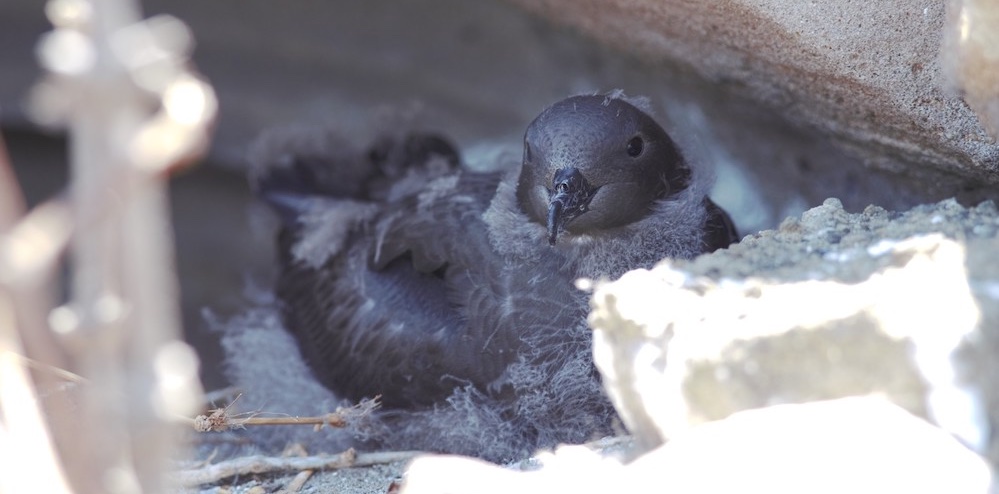Yes, you can now visit Round Island in the Indian Ocean while contributing to a seabird project about Pterodroma petrels. Look out for tropic birds, an egg-eating skink or a passing tortoise!
Time-lapse photography provides a cost-effective, relatively non-invasive method to monitor breeding seabirds. Cameras are programmed to capture images at regular intervals (e.g. one image every hour) and are well suited to collecting data over long time periods. These cameras generate an enormous amount of data, often resulting in hundreds of thousands of images. One of the biggest challenges with this technology is to then turn this wealth of photographic information into a dataset that allows us to answer our research questions.
 A Round Island petrel on its nest
A Round Island petrel on its nest
Citizen science participation has proved a successful way of speeding up image processing, particularly before AI (Artificial Intelligence) can be trained on a new species. One hugely popular citizen science project, in which over 50,000 volunteers from all over the world have participated, is Penguin Watch. Hosted by Zooniverse, volunteers are asked to classify images by tagging and counting penguins. The success of this project has resulted in two more citizen science projects – Seal Watch and Seabird Watch.
This is where I need your help!
 In December 2019, I installed 10 time-lapse cameras on Round Island, Mauritius as part of my BOU Warham-funded PhD. These cameras were set up to monitor the hybrid population of petrels that breed there. More specifically, we want to try to capture the seasonal variation in breeding success, by identifying key phenological dates (e.g. egg-laying, hatching, chick fledging) and the recording of nest success. More information about my fieldwork can be found in my last BOU blog post. Since their deployment, these cameras have taken over 80,000 images! Seabird Watch usually focuses on Black-legged Kittiwakes and Common Guillemots across the North Atlantic, but recently I have been working hard with Tom Hart and Mark Jessopp of Seabird Watch to bring you a more tropical focus – Round Island petrels online!
In December 2019, I installed 10 time-lapse cameras on Round Island, Mauritius as part of my BOU Warham-funded PhD. These cameras were set up to monitor the hybrid population of petrels that breed there. More specifically, we want to try to capture the seasonal variation in breeding success, by identifying key phenological dates (e.g. egg-laying, hatching, chick fledging) and the recording of nest success. More information about my fieldwork can be found in my last BOU blog post. Since their deployment, these cameras have taken over 80,000 images! Seabird Watch usually focuses on Black-legged Kittiwakes and Common Guillemots across the North Atlantic, but recently I have been working hard with Tom Hart and Mark Jessopp of Seabird Watch to bring you a more tropical focus – Round Island petrels online!
 A Round Island petrel chick
A Round Island petrel chick
Anyone with an internet connection from anywhere in the world can get involved. Volunteers are shown a random image from any of the 10 cameras and are asked to ‘tag’ petrels by clicking on them. Volunteers are also asked to classify each record as an ‘adult’, ‘chick’, ‘egg’ or ‘other’. For Round Island, this latter group is used to tag other species, such as the endemic Round Island boa, Telfair skinks, giant tortoises, or other seabirds. If you have never volunteered for one of these projects, you can use an online tutorial as often as you like to understand the classification process (click on Classify, then choose Tutorial instead of Task).
 An example screen view of a petrel nest site from one of the remote cameras
An example screen view of a petrel nest site from one of the remote cameras
So, if you’re interested in seeing the fantastic work that the Mauritian Wildlife Foundation and National Parks and Conservation Service have been doing in order to restore this Island, or are intrigued by this unusual population of Pterodroma petrels, then we would love for you to spend a few minutes helping us with this awesome citizen science project. Keep your eyes peeled for the tortoises and skinks, among many other species, that also inhabit the island!
Just head over to Seabird Watch now seabirdwatch.org
Image credits
All © Round Island Petrel Project




